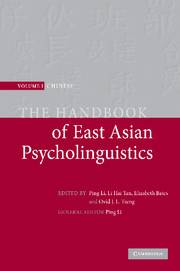Book contents
- Frontmatter
- Contents
- List of figures
- Notes on contributors
- Preface
- Introduction: new frontiers in Chinese psycholinguistics
- Part I Language acquisition
- Part II Language processing
- 14 Word-form encoding in Chinese speech production
- 15 Effects of semantic radical consistency and combinability on Chinese character processing
- 16 Eye movement in Chinese reading: basic processes and crosslinguistic differences
- 17 The Chinese character in psycholinguistic research: form, structure, and the reader
- 18 Perception and production of Mandarin Chinese tones
- 19 Phonological mediation in visual word recognition in English and Chinese
- 20 Reading Chinese characters: orthography, phonology, meaning, and the Lexical Constituency Model
- 21 Processing of characters by native Chinese readers
- 22 L2 acquisition and processing of Mandarin tones
- 23 The comprehension of coreference in Chinese discourse
- 24 Lexical ambiguity resolution in Chinese sentence processing
- Part III Language and the brain
- Epilogue: a tribute to Elizabeth Bates
- References
- Name index
- Subject index
21 - Processing of characters by native Chinese readers
Published online by Cambridge University Press: 05 June 2012
- Frontmatter
- Contents
- List of figures
- Notes on contributors
- Preface
- Introduction: new frontiers in Chinese psycholinguistics
- Part I Language acquisition
- Part II Language processing
- 14 Word-form encoding in Chinese speech production
- 15 Effects of semantic radical consistency and combinability on Chinese character processing
- 16 Eye movement in Chinese reading: basic processes and crosslinguistic differences
- 17 The Chinese character in psycholinguistic research: form, structure, and the reader
- 18 Perception and production of Mandarin Chinese tones
- 19 Phonological mediation in visual word recognition in English and Chinese
- 20 Reading Chinese characters: orthography, phonology, meaning, and the Lexical Constituency Model
- 21 Processing of characters by native Chinese readers
- 22 L2 acquisition and processing of Mandarin tones
- 23 The comprehension of coreference in Chinese discourse
- 24 Lexical ambiguity resolution in Chinese sentence processing
- Part III Language and the brain
- Epilogue: a tribute to Elizabeth Bates
- References
- Name index
- Subject index
Summary
How do adult native Chinese readers represent and retrieve the characters of their language when reading? Over the last decade, my colleagues and I have been conducting research that addresses this question, and the theoretical framework that has emerged from that research is the focus of this chapter. The aim is to present the major issues that need to be considered in relation to the nature of lexical representation at the single character level, and to justify the current position adopted in relation to those issues. The empirical results that are presented as evidence do not in any way constitute an exhaustive survey of the experimental literature, but rather provide an example of the sort of approach that might be taken to address the relevant issues.
At the most general level of description, we can say that a lexical processing system incorporates a representation of the meaning and the form of every word that the language user knows. If the person can read, then the representation of form must exist in terms of orthography as well as in terms of phonology. When a word is presented visually (which is the focus of the current chapter), the system is entered through the orthographic subsystem and this provides access to both meaning (semantics) and pronunciation (phonology). In Chinese, words might consist of one or more characters, but the concern of this chapter is the representation of the characters themselves, which may or may not be words in their own right.
- Type
- Chapter
- Information
- The Handbook of East Asian Psycholinguistics , pp. 237 - 249Publisher: Cambridge University PressPrint publication year: 2006
- 18
- Cited by



